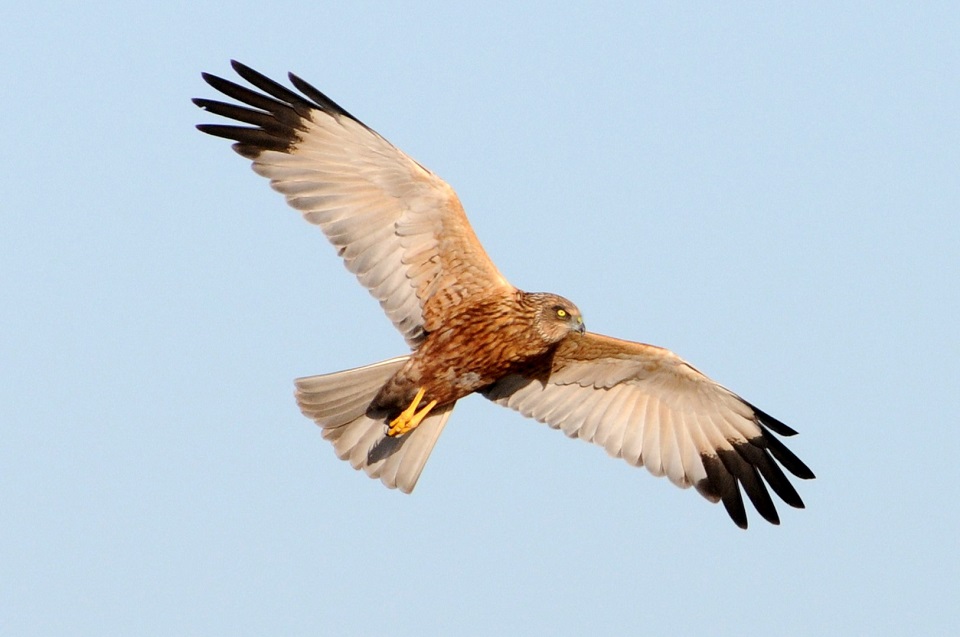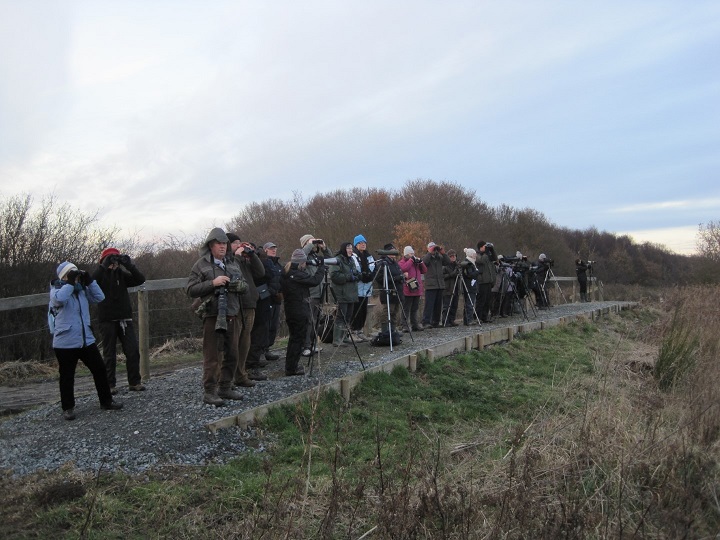There are few things in nature more thrilling than the sight of a magnificent marsh harrier quartering our Broadland landscape, says Norfolk Wildlife Trust Reserves Officer, Robert Morgan.
I'm always bemused by those that say they are going bird-watching. I'm always bird watching: whether it's out of the kitchen window, as a passenger driving along the M40, while attending sporting events or when sunbathing on a beach, I'm always looking to see what birds are about.
School was spent staring out of the classroom window, picking out the fieldfares from the redwings on the playing field, or identifying the gulls gathered under the rugby posts, studiously trying to sort the juveniles by age and species. Once, a male sparrowhawk flew into the assembly hall window, stunning itself for some minutes. I had never seen such a beautiful bird - the talons, the hooked bill, powder grey wings, rufous pink chest and piercing yellow eyes. Of course, one never saw birds of prey then, they had been lost to us. There were a number of factors for their gradual decline, but when DDT came along it effectively exterminated most of our raptors overnight. As a boy I'd see the odd kestrel, I even saw a barn owl once, but a sparrowhawk! It may as well have been a unicorn.
On the reserve, whilst repairing machinery, lugging heavy kit or digging another post-hole, my 'I'm always bird-watching' rule breaks down. I ignore the bearded tits 'pinging' about my head; spoonbill, great white egret and garganey must wait, for there is always a more pressing matter. But the marsh harrier! A common sight in the Broads as it may be; I stop, I stand and I take a moment to stare, driven to it by the sub-conscious schoolboy. Even standing in my own back garden, I point skyward and declare, for the umpteenth time, 'Look! Buzzard.'

Marsh harrier by Nick Appleton
Birds of prey are back. So, okay, now Highland twitchers reluctantly raise their binoculars for another osprey, in the Cotswolds barely anyone is craning their neck to look up at several wheeling kite, and how many people pass Norwich Cathedral as an unnoticed peregrine peers down from the spire? Never in my lifetime did I imagine red kite drifting over the tree tops of Epping Forest or peregrine falcon nesting on Westminster Abbey. With so many tales of woe in the natural world, the recovery of the UK's raptor population is to be celebrated.
A great place to discover these magnificent birds is Norfolk Wildlife Trust's Raptor Watch-point at Hickling Broad and Marshes Nature Reserve. This is probably the best place in the country to see the marsh harrier. In recent winters up to 100 have been counted, drifting in to spend the night in the scrubby hawthorns that are nestled between the grazing marshes and the vast reedbeds that fan out towards Horsey Mere. The impressively restored and sailed Horsey wind-pump stands proud against the skyline, a metaphor that contrasts with the dilapidated Brograve mill that is visible in the distance, now an iconic symbol of the Broad's past.
Marsh harrier were driven to extinction in the UK by the end of the 19th century, but managed to recolonise the Norfolk Broads in the 1920s - then in the 70s, the population plummeted to just one pair. The species has bounced back and Norfolk alone holds on average 80 or so pairs. Although the population is augmented in winter by continental birds, they still remain less numerous than golden eagle. There are few things in nature more thrilling than the sight of a magnificent marsh harrier quartering our Broadland landscape.

Birdwatchers at the Raptor Roost by Norfolk Wildlife Trust
With some luck you may see merlin, our smallest falcon. Often an individual will sit on one of the fence posts, but the raptor that is most anticipated and sends a murmur along the assembled 'birders' is the hen harrier. The male hen harrier is stunning in its blue / grey plumage and black wing tips, while the female is feathered in shades of brown with a white rump. In summer the hen harrier breeds on upland moors, where it is still illegally persecuted, and, unlike the marsh harrier, this practice has hampered the population's growth and expansion.
Although birds can be seen from the watch-point throughout the day, late afternoon leading into dusk is the best time. To get really good views of the harriers, binoculars are needed and bird-watchers recommend a telescope too. However, most 'birders' are normally obliging enough to allow you to 'have a look' and often a Norfolk Wildlife Trust member of staff or volunteer is on hand to help.
Take Action
Raptors are a vital part of the UK's biodiversity and are valuable indicators of the health of the environment. All birds of prey are susceptible to human activity and many are still illegally persecuted. In addition to supporting organisations that value raptors, such as Norfolk Wildlife Trust, you may wish to take part in bird surveys or perhaps just keep a watch on a local nest on your regular walk. If you have suitable space or know someone who does, you could consider mounting a kestrel box in a tree.
The NWT Stubb Mill Raptor Roost watch-point is about a mile and a half walk from the Hickling Broad and Marshes Visitor Centre. The track can be muddy and, depending on livestock, there may be stiles to negotiate. There is limited disabled parking available by the Roost (booking is essential to secure a space), and all other visitors are required to use the car park at the Visitor Centre. Guided walks to the watch-point are available, but check with the Visitor Centre for details.
Header image: Marsh harrier by Andrew Parkinson - 2020VISION